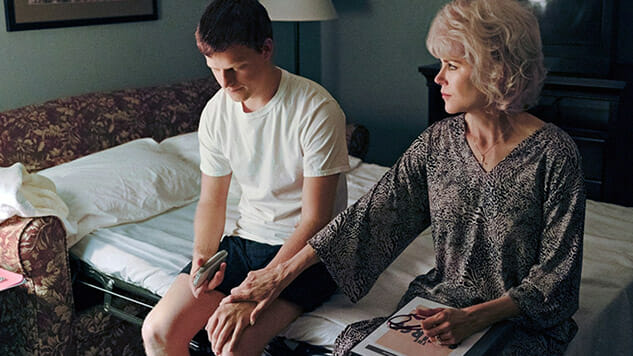Boy Erased and the Loud Spectacle of Gay Trauma
Without a point of view about trauma or pain, Boy Erased ceases to be anything other than a spectacle of it.

If gay shame is deafening, how does gay, and queer, trauma sound? Something maybe like tinnitus: sometimes ignorable, but ultimately ever present.
In Joel Edgerton’s Boy Erased—in which he stars, directing and adapting from Garrard Conley’s memoir of the same name—gay trauma sounds like a combination of Danny Bensi and Saunder Jurriaans’ maudlin, overbearing score, or Troye Sivan’s anachronistic track “Revelation”: always there, yet strangely non-specific.
Jared Eamons (Lucas Hedges) is the son of a successful Baptist pastor (Russell Crowe) and a deferential Southern belle (Nicole Kidman); the film frames his experience at Love in Action, a gay conversion therapy program lead by Edgerton’s charmless fake therapist Victor Sykes, as a series of back-and-forths between Jared’s present and past. In this film, gay conversion therapy exercises are the weapons. Boy Erased takes SparkNotes Freud somewhat literally, forcing its lead to confront what could have made him the way he is, what experiences were most formative, what the magical “key” is to what turned Jared into the person he is now. From considering a family tree of sinners, to his own memories, to an excavation of possible same sex relations, Edgerton follows this line of rhetoric with fairly po-faced sincerity, albeit allowing just enough room for a “born this way” implication to the proceedings. A graphic rape scene between he and a college friend is both a gross (maybe necessary?) red herring and a source of self-loathing, as well as the impetus for Jared to come out to his conservative parents, which then itself becomes the reason why he is submitted to the program. (The details of this event, so I am told, as I have not read the memoir, have been changed from the book, making the scene in the film even more sinister.) And later, as if to alleviate that moment, or provide a sense of personal solace for Jared, an encounter with an artist (Théodore Pellerin) reminds him that real intimacy is possible. Even though it is just a memory.
Through these different kinds of scenes, the film’s palette never changes much. It’s burnt toast, butterless. It does not change when Jared is at home, or when Victor is tormenting other members of the group, and if it does, it slides to grey, giving the impression that warmth is not of interest to the film, that Boy Erased has reached for an icier mood. Similarly, directorial decisions pepper the film in a detached, artificial way. For all the horrid atrocities of abuse and manipulation that exist at the conversion therapy sessions, which are the tip of the iceberg, Edgerton’s not exacting enough a director to push the formal elements of his film and its tone—its cinematography, the acting style of its leads, its sound—to mean much of anything outside of the obvious. The invasiveness of its score and its high contrast shots gesture towards a secret desire to be a full-blown genre film, perhaps a horror movie, but Edgerton hedges his bets back towards mediocre melodrama, which undermines much of the story’s emotional underpinning.
At least with a genre framework, Boy Erased could have had a sense of perspective. It doesn’t. The film is only gay trauma porn. The scene that lingers the most is one in which a point must be proven to Cameron (Britton Sear), timid and overweight, and easily the black sheep of the group. Sykes stages a funeral, to send the message that if Cameron does not change, he will be sent to Hell. Sykes beats him with a Bible and then leads him to what amounts to dorms in the back of the church premises. It’s dramatic and flowy and there is no clear reason why it should be in the film, other than to convey the intended message of “isn’t this all so horrible?”
Well, yeah. But why? The film never really answers that essential question: What about trauma and abuse is so horrible? It can only come up with a stuttering, “W-well, it’s obvious that this is terrible, that no one should have to go through this.” With so much focus on the things around the film, offering an impression of that world (which doesn’t even represent a thorough understanding of its Evangelicalism) and the suffering that occurs at conversion therapy, Edgerton never really has insight about it, or about his main character, other than tragedy. There’s little interiority that can’t be provided by Hedges, who is good in the film; there’s little understanding of the machinations of the systems in place in this environment; there’s little investment into its own credo regarding masculinity (“Fake it till you make it,” a former drill sergeant says, and Sivan’s character Gary parrots back to Hedges); there’s no investigation into the ways in which masculinity is like social capital despite a handful of references (again, with no thoughtfulness) regarding the class context of the story; there’s little care put into the coping mechanisms that people use. What stands out is Boy Erased’s brash music, its mustache curling villain and Hedges’ attempt to hold together his paper-thin character under such distress.
-

-

-

-

-

-

-

-

-

-

-

-

-

-

-

-

-

-

-

-

-

-

-

-

-

-

-

-

-

-

-

-

-

-

-

-

-

-

-

-








































